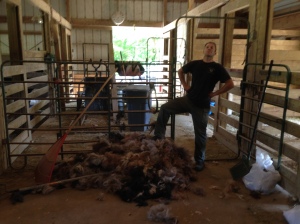Can I just start by saying how blessed I am to have such an amazing husband? I know, some of you are probably sick of hearing about him, but yesterday, when I came up to him while he was in the middle of one of his projects to tell him that a few of my llamas were acting like they were getting pretty hot, he dropped everything he was doing and came with me to the barn immediately to shear a few more. No complaints. No questions asked.

Every year, around this time, we usher in the beginning of summer by shearing. For the past three years or so, Jeremiah has done our shearing himself. (While we were dating, he made the mistake of proclaiming that “I bet I could do that,” after watching someone else shear. Turns out, he could. And he was better at it than the original guy. Guess who got drafted?)
So, why do you shear?
You might not know that llamas and alpacas are wool bearing animals. Though not as famous for that job as sheep, they have a high quality, hypoallergenic wool. Unlike sheep wool, there is no lanolin to complicate the whole wool-to-product process. It’s lovely stuff.
However, in my area of the world, it isn’t just about harvesting a useful animal product, it’s about keeping my llamas safe and happy. Lamas and alpacas are Andean animals from Chile, Bolivia, Argentina, and Peru. While we would probably think of those places as hot, the truth is that, in the mountain ranges, it’s pretty temperate to chilly. Their wool protects them from the chill in those regions. It does a pretty good job of protecting against our winters. It can be a death sentence throughout our summers. We shear our llamas so they don’t overheat AND to harvest their lovely wool. It’s a very symbiotic relationship.

They just…stand there?
I’m not sure why, but most people seem to be under the impression that shearing is a knock down, drag out between us and the llamas. It’s really not. While some animals are more difficult than other–one particularly petulant little monster did manage to kick Jeremiah pretty good this year–most realize that having no wool feels far better than having gobs of it, and they will stand accordingly. (I’ve noticed their behavior for shearing is even better when it’s hot on shearing day.) Even our alpacas, who some people in the industry insist on laying out like sheep, stand very well to be shorn. I’ve heard horror stories of shearers who, for example, tie the animals’ feet and drop them to the ground. In my experience, that sort of procedure is traumatizing and unnecessary. Also, those shearers are the ones most likely to kill an animal by accidentally breaking it’s neck.
How do you decide who to shear first?
I have had several people ask me this year how I decide who to shear first and how I pick their haircuts. (We stretch shearing out over a week or so. Not everyone is shorn on the same day.) It’s fairly commonsense. If an animal looks hot, or has a risk factor (age, especially heavy wool, etc), he or she is shorn early. Older animals, however, end up keeping more of their wool (especially on the neck) because wool growth slows down as they age. I want to make sure they will be able to keep warm over the winter.
What do you do with all of that wool?
With twenty-eight wool-bearing camelids on the ranch, that’s a pretty fair question. Some of the wool is sold; some is given away. Some, especially the wool that isn’t as nice, is thrown out. (There are uses for that wool, such as felting or garden mulch, but I don’t really have the time to deal with it.)

Some, we use to take funny pictures.
Are any of you wondering about llama wool or shearing? (Or llamas in general?) I would love to field questions! Shoot!

I loved this, my little llama expert! Very educational. I want a llama… 😄
LikeLiked by 1 person
I fell in love with a young one, simply because it kissed me.
LikeLike
When we sheared the alpacas, they would squeeze the animal between two large cushions and turn then on their side. The last time I helped neighbors, I disliked the type of table used. There was little control over the very unhappy, scared beast. The last animal managed to break my neighbor’s finger and I was laying on top of it to keep it under control. Really, a 98 pound old woman doesn’t have a chance. Mid July, should be 100 degree temperature, it started to rain—a freezing rain. That’s when we discovered it had lice and I had the top portion of wet, soaked me on top of it. We left after that one and we stunk. You know you live in the country when the country store thinks nothing of your looks and stench. Heck I had to pick up beer (lots of it) before I went home to burn my clothes…
LikeLike
Yikes! That sounds awful! I am not a fan of the way people shear alpacas. I’m sure the critter was almost as traumatized as you were! They will stand up and let you shear them if given half a chance. (We have 6 of the little guys and they are just fine to stand for shearing.)
LikeLiked by 1 person
I don’t plan on helping again, but at least, if I pick up spinning again, I know where to buy that wonderful fiber.
LikeLike